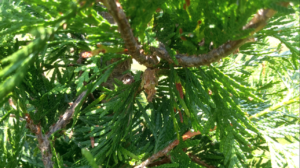
Learn everything you need to know about bagworms with Scientific Plant Service.
Bagworms can pose a serious threat to your landscape, particularly to trees and shrubs. At Scientific Plant Service, we aim to provide you with the knowledge to identify, manage, and treat these pests effectively. Here are five essential things you need to know about bagworms.
What a Bagworm Looks Like
Bagworms are small, caterpillar-like insects that are often hard to spot due to their unique camouflage. They construct protective cases (or “bags”) around themselves using silk and plant materials, which resemble tiny, elongated pine cones or bags hanging from tree branches. These bags can vary in color and texture depending on the host plant. Adult male bagworms are small moths with transparent wings, while the females remain in their bags as wingless, grub-like insects.
Its Feeding Habits and Life Cycle
Bagworms primarily feed on a wide range of trees and shrubs, including evergreens, deciduous trees, and ornamental plants. They start feeding when they hatch in June and continue feeding until late-August. The larvae chew on the foliage, causing significant damage as they grow.
The life cycle of a bagworm consists of four stages: egg, larva, pupa, and adult. Females lay eggs inside their bags in late summer or fall, where the eggs remain over the winter. In spring, the eggs hatch, and the larvae emerge to feed and construct their protective bags. This cycle repeats annually, with a single generation per year. A bagworm can lay as many as 1500 eggs, so it is crucial to control your bagworm infestation before the worms can lay their eggs for the next season.
The Signs of Bagworm Damage
Detecting bagworm damage early is crucial for effective control. One of the first signs is the presence of the characteristic bags hanging from branches. These may initially look like part of the tree or even pine cones, but look closer. The bag may move as worms stick their heads out. As the larvae feed, you may notice defoliation, starting from the top of the tree and moving downward. Severe infestations can lead to significant foliage loss, weakening the plant and making it more susceptible to other stresses and diseases. If you notice your tree quickly becoming sickly in a matter of weeks in the summer, you may have a bagworm infestation. If left untreated, bagworm infestations can kill trees and shrubs, especially evergreens, which do not quickly recover from defoliation.
When to Use Insecticides
Timing is critical when it comes to using insecticides to control bagworms. The best time to apply insecticides is in late spring or early summer when the larvae are small and actively feeding. Insecticides are less effective once the bagworms have reached maturity. Look for products containing Bacillus thuringiensis (Bt), a naturally occurring bacterium that targets young caterpillars, or other recommended insecticides for bagworm control. Always follow the label instructions for application rates and safety precautions.
How to Treat a Tree Damaged by Bagworms
Treating a tree damaged by bagworms involves a combination of immediate and long-term strategies.
- Manual Removal: For minor infestations, manually remove the bags from the trees and destroy them. This can be done in late fall, winter, or early spring before the eggs hatch. However, if you miss even one bag, you may see as many as 500 eggs hatch in the spring.
- Pruning: Prune and dispose of heavily infested branches to reduce the bagworm population and minimize further damage.
- Fertilization and Watering: Support the tree’s recovery by providing adequate water and nutrients. Proper fertilization can help strengthen the tree and promote new growth.
- Monitoring: Consistently inspect your trees and shrubs for signs of bagworm activity. Early detection and intervention are crucial to preventing severe infestations.
- Professional Help: For large infestations or if the damage is extensive, consider seeking professional help. Certified arborists can provide effective treatment plans tailored to your landscape’s needs.
Understanding these five key aspects of bagworms can help you protect your landscape from these destructive pests. At Scientific Plant Service, we are dedicated to providing you with the knowledge and tools to maintain a healthy and beautiful landscape. For more information or assistance, please contact us.
Scientific Plant Service Is Your Go-To Source In Landscape Healthcare
Scientific Plant Service, located in Baltimore, is a privately owned corporation, chartered in Maryland in 1957 by Frank J. Burke. We started as a full-service Arborists specializing in the care of shade trees and ornamental shrubs, but today we are a Lawn Care company that is a huge part of the community. From aquatic environments and snow management to deer and mole control, SPS has services tailored specifically for your lawn and landscape.
We offer services in Maryland, Washington, DC, and Virginia, including: Harford, Baltimore, Carroll, Frederick, Howard, Anne Arundel, Montgomery, Prince Georges, Talbot, Queen Anne’s, Calvert counties in MD, as well as Loudoun County, Fairfax County, Arlington, Alexandria, and Falls Church in VA. For more information, contact us online, or call us at 410-321-0970. Be sure to follow us on Facebook, Twitter, LinkedIn, Instagram, and Pinterest.

